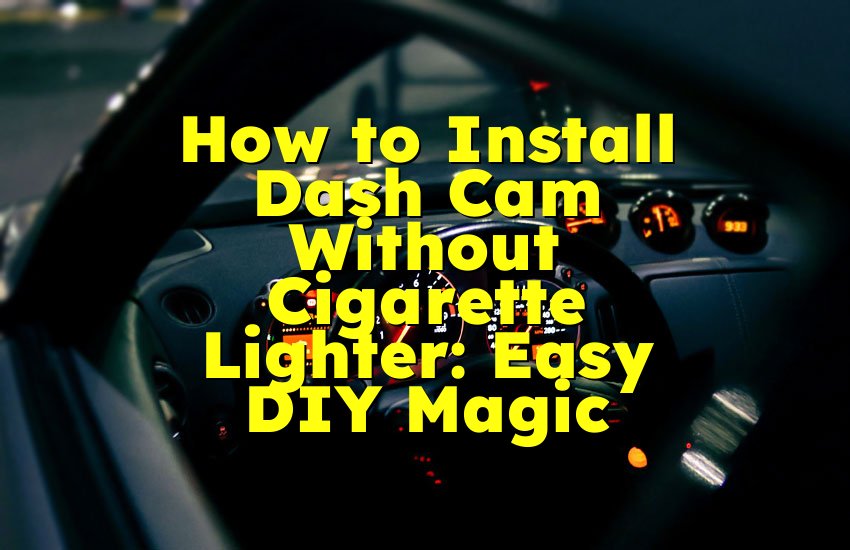As an Amazon Associate, I earn from qualifying purchases at no extra cost to you.
How to Fix a Crack in Your Windshield Fast and Easy
You are driving down the road, and suddenly, a small rock hits your windshield. You hear a loud pop, and there it is—a crack. This happens to many people and can be scary. The good news is, you do not always need to replace the whole windshield. In this article, you will learn how to fix a crack in your windshield by yourself with simple steps.
Look at the Crack Closely
Before doing anything, you need to look at the crack and understand how bad it is. Not all cracks are the same. Some are small and easy to fix, while others are too big and dangerous. Take a few minutes and check if it is a chip, a small crack, or a long line across the glass. Use a flashlight or stand under bright light to see better.
A small crack is usually less than 6 inches. If your crack is small like this, it is safe to repair it yourself. But if it's longer than that or if there are many cracks, it is better to let a professional handle it. A cracked windshield can become weaker over time. If water or dirt gets inside the crack, it can grow. This is why you must fix it as soon as possible.
Next, touch the crack gently with your finger. If it feels smooth and not too deep, it is a surface crack. These are easier to fix. But if your finger catches on the crack, it might be deeper. Deeper cracks may need more care or special repair tools.
Also, think about where the crack is. If it's in your line of sight while driving, even a small crack can be dangerous. Cracks near the edge of the glass can also spread faster. These areas have more pressure.
If you are not sure about the crack, take a picture and show it to someone at an auto repair store. They can help tell you if it's fixable or not. You don't want to waste money on a repair kit if the crack is too bad.
Check your windshield inside and outside. Sometimes a crack can look different from both sides. If the crack goes through both layers of the glass, a full replacement is usually needed.
Here is a quick summary:
- Check how long the crack is
- Look if it's deep or shallow
- See if it's near the edge or in your sight
- Take a picture if unsure
- Ask an expert if needed
Clean the Windshield Properly
Now that you have looked at the crack and decided it can be fixed, the next important thing is to clean the area. You cannot fix a dirty windshield. Dirt, dust, or even water inside the crack can stop the glue from sticking well.
First, park your car in a cool, shaded place. Sunlight can make the crack grow or make the cleaner dry too fast. You want to clean the windshield slowly and carefully.
Use a soft cloth to wipe the area around the crack. Do not use rough materials because they can make more scratches. After that, take a glass cleaner and spray it around the cracked area. Make sure it doesn't drip too much inside the crack. You only need a little.
Now, take a cotton swab or soft toothbrush. Gently clean inside the crack if you can. Try not to press too hard. Your goal is to remove any dust or small pieces of glass. You can also use a can of air (like the ones for cleaning keyboards) to blow air into the crack. This helps remove tiny dirt without touching the glass.
After cleaning, let it dry for at least 15-20 minutes. Do not rush. The glass must be fully dry before you move to the next step. If there's water or cleaner inside, the glue will not hold, and your fix may not work.
Also, do not use soap or household cleaners. They leave behind stuff that can block the glue. Always use a cleaner made for glass.
Another good tip: If you can't fix the crack right away, place clear tape over it. This stops dirt and water from getting inside while you wait. Just remember to remove the tape before you repair it.
To keep it simple:
- Park in the shade
- Wipe gently with a clean cloth
- Use glass cleaner only
- Clean inside the crack with a cotton swab
- Let it dry for 15-20 minutes
- Use clear tape if you need to wait
Get a Windshield Repair Kit
Once your windshield is clean and dry, it's time to get the right tools. You can find a windshield repair kit at auto parts stores or online. These kits are cheap and work well for small cracks and chips. They usually cost between $10 to $25.
Most kits come with:
- A resin (this is a special glue)
- An injector or syringe
- A pedestal or seal
- A curing strip
- A razor blade or small tool to smooth the glass
Make sure the kit you choose says it works for cracks, not just chips. Some kits are only for small round chips, so read the label.
Open the kit and check if all the parts are there. It's best to read the instruction paper that comes with it. Every brand is a little different. Some use a push tool, and others use a suction cup. But don't worry, the idea is the same—get the resin deep into the crack.
Also, do this on a warm day, but not in direct sunlight. The resin needs to flow well. If it's too cold, it might not work. If it's too hot, it can dry too fast.
You might want to wear gloves to protect your hands from the resin. It's not dangerous, but it can be sticky and hard to wash off.
Lay all the tools in front of you so you don't have to look for them while working. Follow the instructions, but here's what usually happens: You place the seal over the crack, use the injector to push the resin in, and then let it sit.
Get ready before you start:
- Buy a good repair kit
- Make sure it says it works for cracks
- Open and check all parts
- Read instructions
- Wear gloves
- Work on a warm, dry day
- Lay tools out neatly
Apply the Resin Carefully
Now the real fix begins. You will apply the resin into the crack using the kit. This is the part that fills the crack and makes it strong again.
Start by sticking the seal or pedestal over the crack. Make sure it covers the crack fully. It needs to stick well to the glass so that no air escapes. Press it down with your fingers for a few seconds.
Next, attach the injector or syringe to the pedestal. Now slowly pull the syringe handle up to suck out the air. This step is important. Air inside the crack makes the fix weak. After pulling air out, push the handle down. This pushes the resin deep into the crack.
You may need to do this push-and-pull action a few times. Don't go too fast. Let the resin move into the crack slowly. You will see bubbles at first. Keep doing it until you see no bubbles.
Once it's done, let the resin sit for 10 to 15 minutes. Then take off the injector and place the curing strip over the crack. The strip is clear and helps the resin dry under sunlight.
Now move your car into the sun or use a UV light. Let it dry for about 20 to 30 minutes. Do not touch the area while it's drying.
After the resin is dry, peel off the curing strip. Use the razor blade from the kit to scrape off any extra glue. Be careful not to scratch the glass.
This part takes patience, but it really works:
- Stick the pedestal over the crack
- Use the injector to pull air out and push resin in
- Watch for air bubbles
- Let it sit for 10-15 minutes
- Use the curing strip
- Dry in sunlight
- Scrape off extra resin
Check the Repair
After fixing the crack, the next thing is to check how well it worked. Your windshield should now look clear and smooth. The crack may still be a little visible, but it should not spread anymore.
First, look at it from different angles. Move your head left and right, up and down. If you still see bubbles or lines, the resin may not have filled the crack completely. That's okay. You can repeat the repair if needed. Most kits allow you to do it again.
Touch the area with your fingers. It should feel smooth. If it's rough, scrape a little more resin off with the razor blade. Don't press too hard. Just use light strokes.
Now take your car for a short drive. Listen for any strange sounds. If the glass is shaking or making noise, the crack may still be weak. Stop and check again.
It's also a good idea to spray water on the area. Use a water bottle and spray a little. If you see water going inside the crack, it's not sealed well. Repeat the repair process.
Even if the crack looks fixed, keep an eye on it for the next few days. Sometimes cracks grow again if the resin was not deep enough.
To be sure your windshield is safe:
- Look from different angles
- Check for bubbles or open spots
- Feel the surface
- Test with water
- Watch it over the next few days
- Repeat the repair if needed
Take Care of Your Windshield
After fixing the crack, you need to take care of your windshield. This helps stop new cracks from forming. Many people fix one crack, then get another one because they don't change how they drive or care for the glass.
Avoid slamming your car doors. This sends pressure through the glass and can make small cracks grow. Close doors gently from now on.
Don't use very hot water to clean your windshield, especially in winter. If your glass is cold and you pour hot water, it can crack fast. Use warm water or a soft brush instead.
Park in the shade when you can. Hot sunlight can heat up the glass, and this may cause cracks to spread. In cold weather, use a sunshade or car cover to keep the glass safe.
Drive slower on roads with small rocks. These can jump up and hit your windshield. Stay back from trucks, because they throw rocks more often.
Clean your windshield often, but use the right cleaner. Never use strong chemicals that can hurt the glass or make it dry and easy to crack.
It's also smart to check your windshield once a week. Look for new chips or lines. If you find any, fix them right away before they grow.
Good habits will keep your glass strong:
- Close car doors gently
- Use warm water, not hot
- Park in shade
- Drive slow on rough roads
- Clean with gentle products
- Check weekly for new cracks
Final Thoughts
Fixing a crack in your windshield is easier than most people think. You just need to take your time, follow the steps, and use the right tools. Doing it yourself saves money and helps you feel proud. A strong windshield keeps you safe on the road. Small cracks can grow if you ignore them, so it’s better to fix them quickly. Now you know how to do it, you'll feel more confident next time. Stay safe and take care of your car—it takes care of you too.
Frequently Asked Questions (FAQs)
Is it safe to drive with a small crack in my windshield?
It might seem safe to drive with a small crack, but it can be risky. The crack may grow while you are driving, especially if the road is bumpy or the weather changes fast. A weak windshield can break more easily during a crash or if something hits it again. It also makes it harder to see clearly. Even a small crack in your line of sight can be dangerous. It’s always best to fix the crack as soon as you can to keep yourself and your passengers safe.
Can I fix a crack in my windshield without a kit?
You might find some home tricks online, like using clear nail polish or toothpaste, but these are not real fixes. They may work for a short time, but they do not make the glass strong again. A repair kit is made with special glue that goes deep into the crack and holds the glass together. Without it, the crack will likely spread. Kits are cheap and easy to use, so it’s better to use the proper tools if you want the crack to stop growing.
Do I need to replace my whole windshield for one crack?
Not always. If the crack is small (less than 6 inches) and not in your line of sight, you can repair it with a kit. But if the crack is too big, deep, or runs across the glass, it’s safer to replace the whole windshield. Also, if there are many cracks or the crack reaches the edge of the glass, a full replacement is usually needed. Fixing it early can help you avoid the high cost of replacement.
Is it hard to fix a windshield crack by myself?
It may look hard at first, but it’s actually pretty simple. Most repair kits come with clear instructions and only take about 30 to 45 minutes to use. You don't need any special tools besides what's in the kit. If you follow the steps carefully and take your time, you can do it even if you've never fixed anything before. Just remember to clean the glass well and do it on a warm day. Many people have done it by themselves with great results.
Can a crack come back after repair?
Yes, it can happen if the crack wasn't filled fully, or if too much stress is put on the windshield. Also, if the resin didn't dry right, the repair may not last. That's why it's important to follow every step and check the crack again after a few days. Avoid slamming doors or driving on rough roads right after fixing it. If the crack grows again, you can try to fix it again or talk to a professional for help.
Do I need to let the resin dry in the sun?
Yes, the sun helps the resin get hard and stay strong. Most repair kits use UV light to dry the resin, and sunlight gives off UV rays. That's why it's best to do the repair on a sunny day. If it's not sunny, you can also use a UV flashlight or lamp. Just make sure the resin dries fully before touching or cleaning the glass. If it doesn't dry enough, it won't hold the crack together, and the repair may not work.
Is it okay to drive right after fixing the crack?
You should wait a little before driving. After the resin dries under sunlight, it usually needs about 30 minutes more to get fully hard. If you drive too soon, bumps in the road could shake the resin before it’s fully dry. That might cause the crack to open again. It's best to give the repair some time to set fully. If you're not in a hurry, wait at least an hour before you drive.
Can a cracked windshield make my car fail inspection?
Yes, in many places, a cracked windshield can cause your car to fail a safety inspection. Even a small crack can be a problem if it's in the driver's line of sight. Inspectors check if the crack blocks your view or weakens the glass. If they think it's unsafe, they won't pass the car. That's why it's smart to fix any cracks before going for inspection. A small repair can save you from a big headache later.











